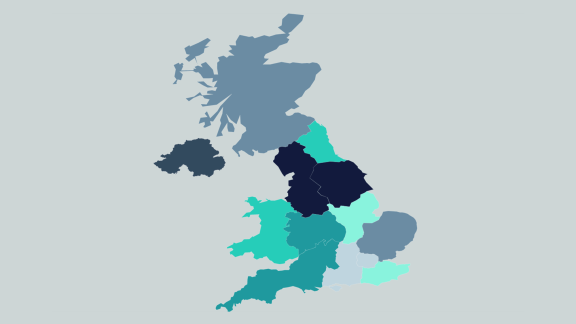Using robotic process automation to enhance the temporary staff bank

Northumbria Healthcare NHS Foundation Trust (NHCT) has developed an automated system to improve how it manages its active and inactive workers on the organisation's staff bank. This has led to efficiencies within the bank, allowing more time to focus on bank worker engagement and ensuring that headcount is accurate for workforce planning purposes and recruitment. This work has improved fill rates, role-focused recruitment drives, levels of engagement, mandatory training, and appraisal compliance rates.
Results and benefits
The robotic automation process has enabled the removal of a significant amount of registered people from the bank who were inactive. It also provided the team with an opportunity to review its recruitment plan to ensure there were sufficient workers who were able and willing to work.
The engagement strategy has helped to encourage individuals to pick up bank shifts more often and because of that there has been a significant improvement in the fill rate. In April 2025 the rate had increased to 82 per cent (from 58 per cent when the project began in January 2023).
Another positive impact is the reduction in agency usage and agency spends. The automation project is also part of the trust’s HR staff bank engagement strategy, which contributes to improving all of their key metrics. Training compliance has increased to over 90 per cent, the appraisal rate is at 97 per cent and a national bank staff survey response rate of 53 per cent.
The morale and satisfaction of the HR staff bank team has also improved, as members now have more time to spend on the priorities of their roles, adding value to the experience of workers instead of chasing up inactive people on the bank. There is also a better relationship with the bank workers themselves, as they feel more involved, engaged, cared for and supported, which increases the likelihood of them picking up shifts
What the organisation faced
Having an active bank is key to running an efficient and effective temporary workforce, that can respond to staffing needs. NHCT undertook a review of its bank workforce and found that there were a significant number of individuals registered on the bank who were not picking up available shifts and were not responding to bank communications.
The HR staff bank team at NHCT is also responsible for the wellbeing, training compliance, appraisal and any other ad hoc work of the bank workers. With such a large workforce, there were challenges with keeping on top of these requirements when workers did not regularly engage. Additionally, there were implications to having an inactive bank as the trust had additional clinical system licences attached to workers.
What the organisation did
The team was frustrated at spending time contacting workers who were not working or engaging. As part of wider discussions within the trust about automation and team efficiencies, the HR staff bank manager reached out to the IT department about creating an automated system which could contact people en masse, thereby reducing the administrative burden on the HR bank team.
From there, a robot was developed and implemented into the trust’s digital setup. The aim was for the robot to use stored data to contact all registered bank workers who were not working and inactive. It functions by accessing the trust’s staff list (via ESR) and its people management software to cross-reference the data of when bank workers had worked shifts.
The robot cross-references all bank workers against staff list and shifts booked. All bank workers who have not worked for four weeks are then contacted via a text and an email. The message states that the team have noticed the worker has not picked up a shift in the last four weeks and checks on the welfare of the individual. It also issues a reminder of the trust’s policy that the expectation is to work a minimum of two shifts per month. Workers are then given an opportunity to either book a shift in the next four weeks to remain active on the bank or to contact the HR staff bank team should they need some support.
After eight weeks, the robot recontacts the individuals who have failed to either pick up a shift or get in touch. The message informs them that in order to stay on the bank they will need to book a shift within the next four weeks or they will be removed.
At 12 weeks, if the individual still hasn’t picked up a shift, the robot contacts them again to inform them that they are being deregistered and should they want to re-join the bank at any time they would need to reapply via the TRAC recruitment page.
There is some human element required for maintaining the system. For example, the team needs to generate a spreadsheet to record individuals who are genuinely unable to work, such as due to sickness reasons (those with a fit note), or parental leave. This has to be continually monitored and updated by members of the team so that the robot can effectively and correctly cross-reference this data too. At the 12-week point, the robot will send the HR staff bank team a list of individuals for deregistering so they can double check it and ensure they aren’t deregistering someone who shouldn’t be on the list.
Overcoming obstacles
Initially there were glitches with the system, whereby the robot was issuing messages to new starters who hadn’t yet begun any assignments. The system requirements were tweaked which allowed the robot to review start dates, so that new starters were excluded from this process. It was noted that there was a requirement for a regular check of the report to ensure the data was up-to-date and filtered correctly. Individuals’ details can be updated and amended through ESR which makes the system operate consistently.
The reasons for workers not engaging with the bank varied. As well as being off sick or having caring responsibilities, some individuals were away travelling, and a number had gone on maternity leave. One worker simply required a new uniform and thought they weren’t allowed to request another, but once the trust made contact and explained they could resolve this for them the individual became an active worker again. As previously referred to, an incident report was made of all the eligible reasons for inactivity so that the system could filter out those affected from receiving reminder messages.
Take away tips
- Identify the appropriate and relevant people to have initial conversations with about developing automated processes.
- Explore what can be done internally to create new systems as it can be simpler and more cost-effective than external alternatives.
- Develop an engagement strategy to keep in touch with bank workers on a regular and consistent basis.
- Keep the process and messaging simple so it doesn’t require too much intervention and management.
- Consider what other things can be done with the time and money saved by incorporating automated processes.
Contact details
For further information contact Claire Coe, HR manager (HR staff bank), Northumbria Healthcare NHS Foundation Trust: Claire.coe@nhct.nhs.uk



